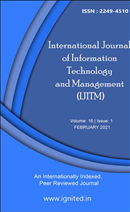A Research on Consumer views of the Impacts of Electronical Commerce
Main Article Content
Authors
Abstract
Commerce is a new term that refers to the practice of buying, selling, or exchanging services andinformation over computer networks. WOM marketing is the informal means of disseminatinginformation from one client to another without the intervention of a marketer. As a result, the study'sgoal is to concentrate on one sort of WOM online user-generated evaluations, despite the fact that othertypes of WOM are equally worthy of inquiry. This study examined the variables that impact and hinder ecommercedeployment among SMEs in the NCR. The convenience sampling strategy was used tochoose 10 SMEs for the sample size. The Statistical Package for Social Sciences (SPSS) software wasused to provide analyses on demographic data, e-commerce benefits, barriers, perceived characteristics,and adoption based on study objectives. Profiles of SMEs will be displayed, along with frequency andpercentage distribution. T-test and ANOVA analyses were also used to evaluate the benefits anddrawbacks of e-commerce for various demographic groups. Despite the fact that other types of WOM areas deserving of inquiry, the current study focuses on one sort of WOM online consumer-generatedevaluations.
Downloads
Download data is not yet available.
Article Details
Section
Articles
References
- Choi, D. H., Kim, C. M., Kim, S., & Kim, S. H. (2006). Customer loyalty and disloyalty in internet retail stores: Its antecedents and its effect on customer price sensitivity. International Journal of Management, 23, 925- 941,944. doi: 1197221341
- Choi, J., & Geistfeld, L. (2004). A cross-cultural investigation of consumer e-shopping adoption. Journal of Economic Psychology, 25(6), 821-838.
- Dembla, P. Palvia, P., & Krishnan, B. (2007). Understanding the adoption of web-enabled transaction processing by small businesses. Journal of Electronic Commerce Research, 8(1), 1-17. doi: 1230897421
- Drew, S.A.W. (2003). E-Business research practice: Towards an Agenda. Electronic Journal on Business Research Methods 1(1).
- Hamill, J., & Stevenson, A. (2002). International marketing and the Internet. International Marketing Review, 19 (2/3), 323.
- Harrington, L. and Reed, G. (1996). Electronic Commerce Finally Comes of Age. The Mckinsey Quarterly, 2, 68-77.
- Haynes, P., Becherer, R. and Helms, M. (1998), "Small and mid-sized businesses and Internet use: unrealized potential?", Internet Research: Electronics Networking Applications and Policy, Vol. 8 No. 3, pp. 229-35.
- Kalakota, R., & Robinson, M. (2001). e-Business 2.0 roadmap for success (2.0 ed.). New Jersey: AddisonWesley.
- Kharbanda, V.P. (2001), “Facilitating innovation in Indian small and medium enterprises – the role of clusters”, Current Science, Vol. 80 No. 3, pp. 343-8.
- Korper, S. and Ellis, J. (2001), The E-Commerce Book, Academic Press, San Diego, CA.
- Mandal, P. (2004). Inter-country analysis of e-business. Journal of Global Information Technology Management, 7(2), 1-5.
- Palvia, P., & D'Aubeterre, F. (2007). Examination of infomediary roles in B2C e-commerce. Journal of Electronic Commerce Research, 8,207-220. doi: 1388674851 992.
- Poon, S. (2000), “Business environment and Internet commerce benefit – a small business perspective”, European Journal of Information Systems, Vol. 9, pp. 72-81.
- Ratnasingam, P. (2005). Trust in inter-organizational exchanges: A case study in business to business electronic commerce. Decision Support System, 39, 525-544.
- Rose, G., & Straub, D. (1998). Predicting General IT use: Applying TAM to Arabic world. Journal of Global Information Management, 6(3), 39-46.
- Sarkar A, "E-Commerce Adoption and Implementation in SMEs: An Analysis of Factors", 21st Annual Conference of the National Advisory Committee on Computing Qualifications (NACCQ), Auckland, New Zealand, 2008: 309-319.
- Schulze, C. and Baumgartner, J. (2001), Don’t Panic, Do E-Commerce, A Beginner’s Guide to European Law Affecting E-Commerce, European Commission’s Electronic Commerce Team.
- Turban, E., King, D., Lee, J., & Viehland, D. (2004). Overview of electronic commerce. In R. Horan Editor. Electronic Commerce: A managerial perspective 2004 (pp.1-34). Upper Saddle River, New Jersey: Prentice Hall.
- Wong, Y., Hsu, C., & Steele, R. (2005). Technology acceptance model (TAMCom) for business to customer (B2C). Department of Management, Griffith University, Australia.
- Zimmerer, T.W. and N.M. Scarborough (1998), Essentials of entrepreneurship and small business management, Upper Saddle River, NJ: Prentice Hall.
- Zwass, V, (1996), 'Electronic Commerce: Structures and Issues', IJEQ Volume 1, no. 1, pp. 3-23.

